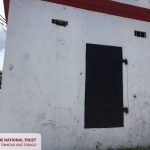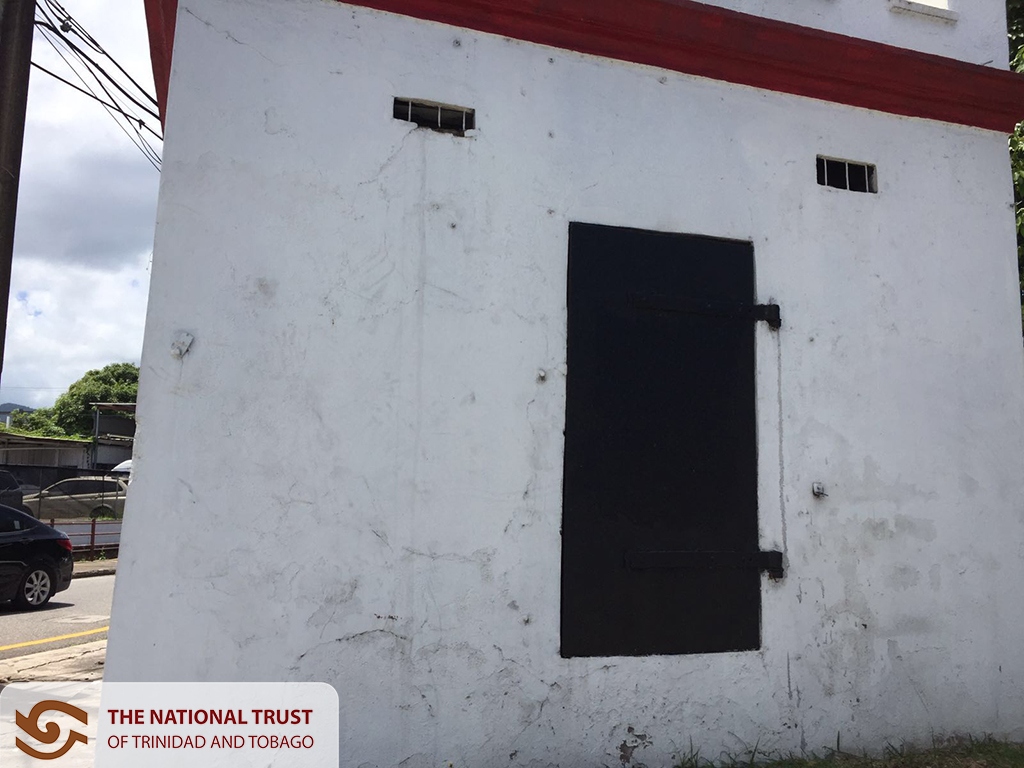
Humphrey’s film vault, located at the edge of Wrightson Road opposite the Fire Station, is an old structure coexisting with modern buildings and bustling motor vehicular traffic. It was built in the 1920s by Guyanese-born cinema pioneer William Pettigrew Humphrey after whom the structure is named. In those days, going to the cinema was a popular pastime which many Trinidadians enjoyed. However, there was a problem: films were recorded on celluloid film stock which was a highly flammable material. Usually, countless film reels were stored in vaults, basements and dedicated storage rooms. Humphrey stored his films at his offices on Broadway. However, due to the high risk of accidental fires, the then constabulary commanded him to store his films outside city limits. Thus, he built the medieval-looking concrete storage bin that we see today. At the time, the vault lay at the sea’s edge in a fishing village known as Corbeaux Town.
Around the time the film vault was installed, the town underwent drastic alterations. In 1922, mayor Dr A.H. McShine, had begun to rid the community of its residents. Further, there were plans developed by city engineer Ranjit Kumar to extend Wrightson Road westward and to make it into a two-way road. For this to occur, the sea at Corbeaux Town had to be reclaimed. Thus, when the road was completed in 1940, the Humphrey Film Vault was left marooned inland.
In any event, the structure soon fell out of use as Humphrey died the very next year in 1941. Moreover, the risk of films burning was greatly removed after celluloid film was replaced by cellulose acetate film, or safety film in the 1950s which was not as combustible. Humphrey’s film vault remains a relic of a transitioning Port of Spain as well as an era where cinema-going was popular entertainment.
Resources:
Bissessarsingh, Angelo, “The History of Corbeaux Town.”
https://www.facebook.com/groups/191766699268/permalink/10156242436254269/
—, “Recounting the Corbeaux Town days.”
https://www.guardian.co.tt/article-6.2.406994.8e5c1b3012
“William Pettigrew Humphrey.”
https://gw.geneanet.org/delabastide5248?lang=en&n=humphrey&oc=0&p=william+pettigrew
Image of William Pettigrew Humphrey
https://www.caribbean-beat.com/issue-54/glory-days-coming-back#axzz6SvrYH6HE
THE HISTORY OF CORBEAUX TOWN
Until the Port-of-Spain harbour was reclaimed in the 1930s, the sea approach was very shallow,necessitating the landing of passengers and goods at a wooden jetty called St Vincent Wharf because it ran into St Vincent Street. To the west was a low mudflat which had a sandy beach. To the north was the sugar cane of Woodbrook Estate. This area became quite populated in the1830s after emancipation as a place for fishermen and boatbuilders. The beach was also the place where the marchandes or hucksters of the city would come and haggle with the fishermen in their boats for the catch. The fish would then be taken on a wooden tray on the heads of the marchandes with the cry of ‘Poisson frais…poisson frais…feeesh..fressh feesh” ringing in the morning air. Naturally, the offal of the gutted fish attracted the birds which gave the area its name, as they were snidely described in 1847 by CW Day, who compared them to practitioners of the law: “The streets are kept very clean and a species of buzzard or carrion vulture erroneously called Corbo, or crow, are the authorised scavengers. These birds, which are black, and as large as young turkeys, have long gawky legs, keen eyes, an iron-grey cowl covering their necks, which gives them a ludicrous resemblance to barristers in costume. They are knowing fellows too, and fight as keenly for their offal as any gentleman of the bar can do for his fee. It is very droll to see them in the morning, after a night’s dew or rain, sitting in rows on the house tops, spreading out their wings to dry.”
[show_more more=”Click here to read more” less=”Click here to close”]
Corbeaux Town will forever be immortal as the subject of great art for it is here that Trinidad’s consummate artist Michel Jean Cazabon (1813-1888) came many a morning to capture in Corbeaux Town will forever be immortal as the subject of great art for it is here that Trinidad’s consummate artist Michel Jean Cazabon (1813-1888) came many a morning to capture in erected a fish market. There were many masters of marine crafts resident at Corbeaux Town, including net makers who with lightning precision, could make yards and yards of seine. Boat – builders were the other great craftsmen, often working from the shade of a coconut tree,shaping lumber with adzes. Seasoned timber from the high woods combined with pitch-pine sawn on the other end of town at the La Basse sawmill comprised the main fabric of the sloops and pirogues they built. Wooden dowels were used to hold the boats together, since iron nails would rust and compromise the integrity of the vessels. Around 1900, a roadway was extended through the area, cutting across lower Sackville Street. It was named after its engineer, Walsh Wrightson. Corbeaux Town continued much unchanged until the 1920s. A small concrete storage bin looking like a medieval keep was erected at the water’s edge. It belonged to William Pettigrew Humphrey, who was an early local cinema pioneer. In those times, the celluloid film reels were highly flammable. Port-of-Spain was forever under the threat of fire, having been completely razed in 1808 and 1895, so that the constabulary mandated Humphrey to store the films outside city limits instead of at his offices on Broadway.
The last days of Corbeaux Town came in 1936-38 when a young and dynamic city engineer named Ranjit Kumar decided to turn Wrightson Road into a dual carriageway, which necessitated the reclamation of the swampy land between Walsh Wrightson’s original route and the sea. This meant that Corbeaux Town would be left high and dry. Even before this, however, the end was in sight. From around 1922 the dynamic mayor, Dr AH McShine, had commenced plans for slum clearance and eradication of the noisome barrack yards of the city. This was supported by the city medical officer, Dr GH Masso, who himself had been born into humble circumstances in Corbeaux Town. Slowly and steadily Corbeaux Town began to change and became more gentrified, albeit still a place where fishing boats were built and used and nets hung out to dry. The extension of Wrightson Road was largely completed by 1939 and fully so by 1940. The Humphrey Film Vault was left marooned inland and can still be seen at the intersection of Charles Street and Wrightson Road. A year later the American Army moved into the area known as Docksite and set up camp, where it remained until 1946, after World Warr II ended. Even though Corbeaux Town disappeared, the last boat- builder remained in a shed near the old area until the 1970s.
[/show_more]
Angelo Bissessarsingh
Published: Sunday, September 1, 2013
Other Known Name: Humphrey’s Film Vault
Address: Intersection of Charles Street and Wrightson Road
Town/City: Port of Spain
Region: Port of Spain
Site Type: Cultural Heritage
Ownership:
Public Accessibility:
Cultural Community: British
Site Features: Private Buildings
Intersection of Charles Street and Wrightson Road, Port of Spain


